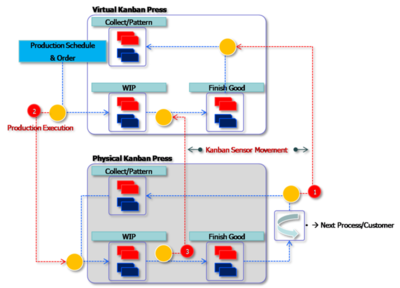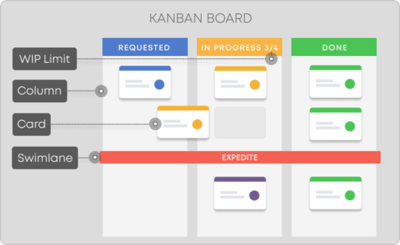Difference between revisions of "Kanban"
| Line 1: | Line 1: | ||
'''Kanban''' is one of the approaches for [[Agile Methodology|Agile]] Implementation, which was first used and developed by Taiichi Ohno. Taiichi Ohno was working as an Industrial Engineer at the Japanese company Toyota. It is an approach which uses a visual system for[[Workflow|managing the work as it moves forward]]. While Taiichi Ohno developed it for the manufacturing work, it was not until 2004 when David J. Anderson used this method for [[Information Technology (IT)|IT]] [[Software Development]], and since then, it has become one of the most popular agile development approaches.<ref>Definition - What Does Kanban Mean? [https://www.educba.com/what-is-kanban/ EduCBA]</ref> | '''Kanban''' is one of the approaches for [[Agile Methodology|Agile]] Implementation, which was first used and developed by Taiichi Ohno. Taiichi Ohno was working as an Industrial Engineer at the Japanese company Toyota. It is an approach which uses a visual system for[[Workflow|managing the work as it moves forward]]. While Taiichi Ohno developed it for the manufacturing work, it was not until 2004 when David J. Anderson used this method for [[Information Technology (IT)|IT]] [[Software Development]], and since then, it has become one of the most popular agile development approaches.<ref>Definition - What Does Kanban Mean? [https://www.educba.com/what-is-kanban/ EduCBA]</ref> | ||
| + | |||
| + | |||
| + | __TOC__ | ||
| Line 47: | Line 50: | ||
| − | == Kanban Vs. Scrum | + | == Kanban Vs. Scrum<ref>Kanban Vs. Scrum [https://www.atlassian.com/agile/kanban/kanban-vs-scrum Atlassian]</ref> == |
“Kanban vs. scrum” is a discussion about two different strategies for implementing an agile development or project management system. Kanban methodologies are continuous and more fluid, whereas scrum is based on short, structured work sprints. | “Kanban vs. scrum” is a discussion about two different strategies for implementing an agile development or project management system. Kanban methodologies are continuous and more fluid, whereas scrum is based on short, structured work sprints. | ||
| Line 53: | Line 56: | ||
Kanban is all about visualizing your work, limiting work in progress, and maximizing efficiency (or flow). Kanban teams focus on reducing the time a project takes (or user story) from start to finish. They do this by using a Kanban board and continuously improving their flow of work. Scrum teams commit to shipping working software through set intervals called sprints. Their goal is to create learning loops to quickly gather and integrate customer feedback. Scrum teams adopt specific roles, create special artifacts, and hold regular ceremonies to keep things moving forward. | Kanban is all about visualizing your work, limiting work in progress, and maximizing efficiency (or flow). Kanban teams focus on reducing the time a project takes (or user story) from start to finish. They do this by using a Kanban board and continuously improving their flow of work. Scrum teams commit to shipping working software through set intervals called sprints. Their goal is to create learning loops to quickly gather and integrate customer feedback. Scrum teams adopt specific roles, create special artifacts, and hold regular ceremonies to keep things moving forward. | ||
| + | |||
| + | |||
| + | [[File:Kanban Vs Scrum.png|400px|Kanban Vs Scrum]]<br /> | ||
| + | source: Atlassian | ||
Revision as of 14:48, 1 October 2021
Kanban is one of the approaches for Agile Implementation, which was first used and developed by Taiichi Ohno. Taiichi Ohno was working as an Industrial Engineer at the Japanese company Toyota. It is an approach which uses a visual system formanaging the work as it moves forward. While Taiichi Ohno developed it for the manufacturing work, it was not until 2004 when David J. Anderson used this method for IT Software Development, and since then, it has become one of the most popular agile development approaches.[1]
Types of Kanban Systems[2]
In a Kanban system, adjacent upstream and downstream workstations communicate with each other through their cards, where each container has a Kanban associated with it. Economic Order Quantity is important. The two most important types of Kanbans are:
- Production (P) Kanban: A P-Kanban, when received, authorizes the workstation to produce a fixed amount of products. The P-Kanban is carried on the containers that are associated with it.
- Transportation (T) Kanban: A T-Kanban authorizes the transportation of the full container to the downstream workstation. The T-Kanban is also carried on the containers that are associated with the transportation to move through the loop again.
The Kanban philosophy and Task Boards are also used in Agile project management to coordinate tasks in project teams. An online demonstration can be seen in an Agile Simulator.
Implementation of Kanban can be described in the following manner:
- The workflow consists of logical steps.
- There are two steps to a workflow viz. queue and work in progress/process.
- The team in charge decides on the maximum amount of work each step of the workflow can hold.
- Work is pushed into the queue step and pulled into the process step.
- If need be, work is halted in two successive stages to clear bottleneck.
Kanbrain
A third type involves corporate training. Following the just-in-time principle, computer-based training permits those who need to learn a skill to do so when the need arises, rather than take courses and lose the effectiveness of what they've learned from lack of practice.
Electronic Kanban
Many manufacturers have implemented electronic Kanban (sometimes referred to as e-Kanban) systems. These help to eliminate common problems such as manual entry errors and lost cards. E-Kanban systems can be integrated into enterprise resource planning (ERP) systems, enabling real-time demand signaling across the supply chain and improved visibility. Data pulled from E-Kanban systems can be used to optimize inventory levels by better tracking supplier lead and replenishment times.
E-Kanban is a signaling system that uses a mix of technology to trigger the movement of materials within a manufacturing or production facility. Electronic Kanban differs from traditional Kanban in using technology to replace traditional elements like Kanban cards with barcodes and electronic messages like email or Electronic data interchange.
A typical electronic Kanban system marks inventory with barcodes, which workers scan at various stages of the manufacturing process to signal usage. The scans relay messages to internal/external stores to ensure the restocking of products. Electronic Kanban often uses the internet as a method of routing messages to external suppliers and as a means to allow a real-time view of inventory, via a portal, throughout the supply chain.
Organizations like the Ford Motor Company and Bombardier Aerospace have used electronic Kanban systems to improve processes. Systems are now widespread from single solutions or bolt on modules to ERP systems.
Kanban Board[3]
A Kanban board is a tool for workflow visualization and a key component of the Kanban method. Visualizing your workflow and tasks on a Kanban board helps you better understand your processes and gain an overview of your workload. Kanban boards use Card, Column, Swimlanes, and WIP Limits to enable teams to visualize and manage their workflows effectively.
- Kanban Cards – This is the visual representation of tasks. Each card contains information about the task and its status, such as deadline, assignee, description, etc.
- Kanban Columns – Each column on the board represents a different stage of your workflow. The cards go through the workflow until their full completion.
- Work-in-Progress Limits – They restrict the maximum amount of tasks in the different stages of the workflow. Limiting WIP allows you to finish work items faster by helping your team focus only on current tasks.
- Kanban Swimlanes – These are horizontal lanes you can use to separate different activities, teams, classes of service, and more.
Kanban Vs. Scrum[4]
“Kanban vs. scrum” is a discussion about two different strategies for implementing an agile development or project management system. Kanban methodologies are continuous and more fluid, whereas scrum is based on short, structured work sprints.
When implementing agile and DevOps, Kanban and Scrum provide different methodologies for managing complex work. It's easy to point out the differences between scrum practices and Kanban practices, but that's just at the surface level. While the practices differ, the principles are largely the same. Both frameworks will help you build better products (and services) with fewer headaches.
Kanban is all about visualizing your work, limiting work in progress, and maximizing efficiency (or flow). Kanban teams focus on reducing the time a project takes (or user story) from start to finish. They do this by using a Kanban board and continuously improving their flow of work. Scrum teams commit to shipping working software through set intervals called sprints. Their goal is to create learning loops to quickly gather and integrate customer feedback. Scrum teams adopt specific roles, create special artifacts, and hold regular ceremonies to keep things moving forward.



